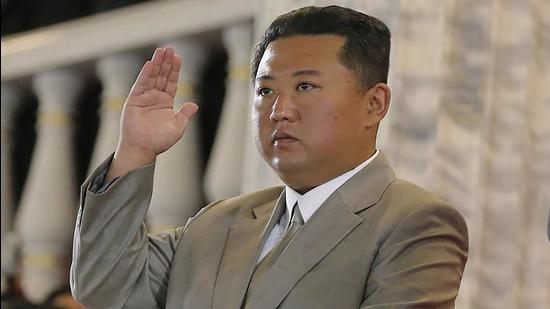Aimed at Joe Biden, a new act in North Korea’s nuclear drama
At the end of August, the International Atomic Energy Agency (IAEA) reported that it had detected suspicious activity from North Korea’s Yongbyon nuclear plant. Yongbyon had been temporarily shuttered in 2018 in the heyday of Kim’s bonhomie with the then President Donald Trump
Kim Jong Un has been a busy man. In the last few weeks, North Korea has restarted a previously dormant nuclear facility, tested a new cruise missile, and launched ballistic missiles that landed in the Sea of Japan. This flurry of provocations — simply the latest in the long saga of the Hermit Kingdom’s nuclear drama — is aimed at an audience of one: Joe Biden.

At the end of August, the International Atomic Energy Agency (IAEA) reported that it had detected suspicious activity from North Korea’s Yongbyon nuclear plant. Long a mainstay of the reclusive nation’s nuclear programme, Yongbyon had been temporarily shuttered in 2018 in the heyday of Kim’s bonhomie with the then President Donald Trump, as a token of the dictator’s commitment to reaching a settlement on his nuclear arsenal with the United States (US).
While no longer as crucial to North Korea’s nuclear plans as it once was, Yongbyon remains the nation’s only source of plutonium and tritium, key elements for manufacturing the cutting-edge thermonuclear weapons that North Korea hopes to build, and the rest of the region dreads.
Only a short while after, the North Korean State media reported that the nation’s defence establishment had successfully tested a new cruise missile. The missile, State media crowed, was a “strategic weapon”: Pyongyang-speak for a potentially nuclear-capable device.
Also Read | ‘Will make them realize’: North Korea warns US, South Korea over ‘hostile acts’
With this addition to its substantial and growing armoury, the belligerent State has further complicated defence and strategic calculations for the US, Japan and South Korea. This was followed swiftly by a ballistic missile launch that ended up in the Sea of Japan and sent alarm bells ringing in regional capitals.
All this begs a simple question: Why?
North Korea’s carefully calibrated provocations are an indication that Kim Jong Un is once again ready to talk to the US. He has followed a long-established North Korean playbook: Create an artificial crisis, force opposing parties to the negotiating table, extract concessions, and repeat. By restarting Yongbyon and flexing his country’s nuclear muscle, Kim hopes to create enough pressure on President Biden to restart the US-North Korea talks that fell apart in Stockholm in 2019.
Longtime observers believe that chairman Kim is out to relieve some of the economic pressure that his country has faced since the imposition of crippling United Nations sanctions on the country after it conducted similar missile tests in 2016 and 2017. The isolated nation’s long-suffering economy has depended heavily on Chinese largesse since.
However, the onset of Covid-19 forced chairman Kim to close his nation’s borders, which led to a sharp contraction in trade with China, and caused North Korea’s worst economic contraction in over 20 years. By holding talks with Biden, Kim hopes to barter some of his sizeable nuclear arsenal for sanctions relief in a desperate play to keep the country running on an even keel.
President Biden now finds himself in a bind.
Should Biden ignore North Korea’s signalling for talks, Kim will have every incentive to continue to develop and test more sophisticated weapons. This would be unacceptable to Americans, given that North Korea already possesses the ability to strike the continental US.
However, despite Biden’s willingness to engage with the regime, Pyongyang has refused to meet Biden’s special representative for North Korean affairs.
Speculation is rife that, having been feted at the highest level by former President Trump, Kim and his top advisers will settle for nothing less than a direct dialogue between Biden and Kim.
Given Biden’s stated reluctance to eschew the more personalised Trump formula for a more traditional diplomatic approach, a gulf already exists between both sides.
Should these matters of protocol be resolved, even thornier issues remain. While the US has long held that it will only be satisfied with a complete dismantlement of North Korea’s nuclear capabilities, it has become increasingly evident that Pyongyang has no intention of parting with its hard-won weapons.
North Korea’s nuclear weapons not only provide an effective deterrent against potential US military action on the Korean peninsula, but also allow a struggling and destitute State to deal, on equal terms, with the world’s most powerful nation.
Nevertheless, Biden does have room for creative Statecraft. While the US can continue to call for complete denuclearisation in principle, Biden’s team may consider negotiating a phased arms control agreement. Such an agreement would set clear and specific timelines for North Korean actions such as the dismantling of Yongbyon and a moratorium on new weapons development and testing.
Once the US and allied partners such as South Korea verify compliance, sanctions relief and economic investment could be provided to the regime in Pyongyang. To be sure, such a deal would not be perfect by any stretch. It would require a thorough inspection regime which Pyongyang has been reluctant to allow in the past.
Further, it would undoubtedly raise the hackles of Biden’s conservative opponents at home. However, such a deal would allow Biden to succeed where Trump failed by recognising a simple truth: While the US can no longer roll back Pyongyang’s nuclear status, it can creatively shape the regime’s capabilities in a way that diminishes the threat to America and its allies.
Given what is at stake for global security, one can only hope that the Biden team shakes off the debacle in Afghanistan and steps up to the mark.
Shashank Mattoo is a graduate student at the University of Cambridge and research associate at Observer Research Foundation
The views expressed are personal
All Access.
One Subscription.
Get 360° coverage—from daily headlines
to 100 year archives.



HT App & Website






